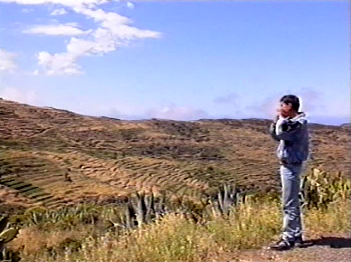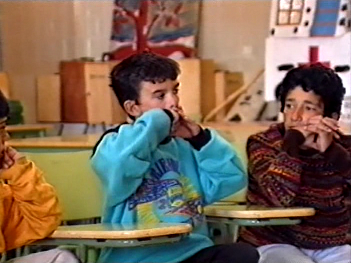Imagine you're a shepherd, and, more importantly, you need to borrow some knives or something from your neighbor. The only problem is that your neighbor is also a shepherd, and there are about a thousand places he could be. You could spend all night yelling and not find him! Moreover, to even get close to him would mean descending a long footpath, ascending another one, and then wandering around his pastureland for an hour or so. And whether you find him or not, you'll have to go all the way back before your sheep do something stupid, like knock over a lamp or join a cult or whatever.
This was what the residents of La Gomera faced in their daily lives. To compensate, they developed a powerful solution, a system of instantaneous long-distance communication: el Silbo Gomero (Literally, "Gomeran Whistle"), a fully functional whistled dialect of Spanish. And it's awesome.

El Silbo has a well-known history. The original inhabitants of La Gomera were believed to be immigrants from part of what is now Mauritania, and they spoke a tonal language. Tones were so important to the phonology of the language that one could speak simple sentences with just the tones and not lose meaning. This rudimentary system evolved to include glides and stops to imitate consonants, which let whistlers convey more complex phrases. In the 16th century, when the Spaniards conquered the island, the natives were driven to extinction. But the Guanches, Spanish immigrants, adapted the Gomeran whistle to their native Spanish. Spanish does not have phonologically significant tones, so pitch variations are used to represent vowels. The system worked great for the shepherds and farmers. In the 1990's, when modernization brought the number of whistlers to a dangerous nadir, the government of La Gomera made el Silbo a mandatory subject for elementary students, which successfully sparked a whistling renaissance.

Now, this isn't the only whistled language. There are literally hundreds more. Most, if not all, arose as a means of addressing the problem of communicating over long distances, where yelling was no longer viable. Whistled languages were prevalent in three different types of land:
- Mountains, where steep slopes or heavy snows left people physically isolated even if they could see each other. Some examples of mountain whistle languages are Aas, from the French Pyrenees (which went extinct in the 70's); Chepang, from the Nepalese side of the Himalayas; and yes, Silbo Gomero.
- Jungles, where the dense flora restricted sound propagation. For hunting groups, good communication is vital, and whistles can travel over six times farther than hollers while still remaining coherent. Examples of jungle whistled languages are Pirahã, Gasup from Papua New Guinea, and the Mazatecan languages of Central America. I have a completely unfounded hunch that being descended from a whistling culture is the reason why seemingly everyone in Oaxaca today is a master whistler.
- Deserts. Specifically, West Africa. This same region is also known for the talking drum. Also, they may be descended from the same tribes that were the first to colonize (and whistle on) La Gomera. Examples of desert whistled languages—well, when I said above that there were literally hundreds of whistled languages, I didn't mention that most of them are from West Africa. There are too many for me to even begin.
- There's also the village of Kuşköy in Turkey. I don't actually know the lay of the land around there, so I don't know if it even fits into one of the above categories. Regardless, it's probably the second-most thoroughly documented whistled language after el Silbo, so I feel it deserves a mention.
Jeff Brent has the most complete English collection of resources on the language, including a self published book and a handful of authorized translations. The government of La Gomera offers a bunch of educational resources on el Silbo (in Spanish, natch). They have a set of three videos that they offer to universities. In winter of 2007-2008, I went to great lengths to convince them to a copy to me, a high school punk. A few weeks later, I received a slightly grainy PAL VHS, which I promptly converted to DVD. As far as I know, this is the only digital version of these videos in existence. I am presently debating whether or not to put them online. Those pictures you see above are stills from parte uno, which makes them an I Miss Kircher Society Dot Org Dot Blogspot Dot Com Exclusive (IMKSDODBDCE)!
And yes, I did originally learn about el Silbo from the old kirchersociety.org.
No comments:
Post a Comment